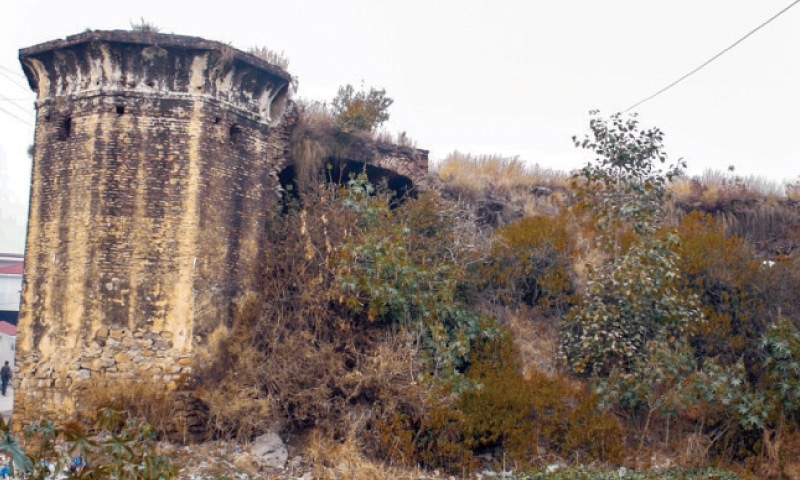
The 16th century Mughal-era inn, locally known as Sarai-i-Kharbooza, presents a picture of neglect as it has been illegally occupied, decaying due to lack of preservation and maintenance.
The fascinating Sarai Kharbooza (Melon’s Inn) located along G.T. Road near Taxila is among hundreds of inns which were built to facilitate travellers and the royal army.
It has been observed that the basic structure of the inn is based on a square along with four octagonal bastions on each side. It was built from boulders and burnt bricks. The boulders are melon-shaped, which is why the inn got the name Sarai-i-Kharbooza.
Historical evidence shows that when this building was not abandoned it had two gates where many shops were located. The living quarters still retain some of their original design and colours, especially the beautifully embellished panels on the alcoves.
This inn also has a three-domed mosque right at its centre and was repaired on different occasions by the local population with some extensions in its main structure.
However, the living quarters and a mosque also maintain their originality with frescoes and splendid ornamentation on the ceilings and the arch.
According to local archeologists, the mosque is similar in design to the one believed to be built by Emperor Akbar in Kuri on the suburbs of Islamabad.
According to Abdul Nasir Khan, curator of Taxila Museum, during the 16th century, Mughals earmarked a place for resting and built a dome on the building.
He said Emperor Jahangir had mentioned Sarai-i-Kharbooza in his Tuzuk-i-Jahangiri as he stayed here on his way to Delhi. It is said Sher Shah Suri had got this inn built on his Grand Trunk Road that stretched from Kabul to Kolkata.
Caravans used to stay at this protected area where travellers as well as the royal army contingents took a break here during their journey. Talking about its architecture and structure, he said the inn was modeled on the lines of Persian inns.
Half of the area of Sarai-i-Kharbooza is illegally occupied by local inhabitants while the other half is in dilapidated condition due to lack of official patronage, maintenance and preservation by officials of the Federal Department of Archaeology and Museums.
It has also been observed that a private contractor had demolished the outer wall of the site and its bricks were allegedly taken for personal use.
Some of the structures have either been razed or turned into a cattle pen.
When contacted, Centre of Culture Development head Dr Nadeem Umer Tarrar said due to official apathy the local people were destroying national heritage site.
“We have frequently requested the Federal Department of Archaeology and Museums as well as the Ministry of National Heritage to pay attention to the decay and illegal occupation of the site but the concerned authorities have paid no heed to our appeals,” Mr Tarrar added.
Responding to a question, he said after the 18th constitutional amendment, the Federal Department of Archaeology and Museums holds the primary responsibility of protecting historical monuments within the federal capital territory.
“I have been requesting the director general archaeology to look into the matter and take urgent steps to check the ongoing demolition of the historic monument otherwise it will be an irreparable loss to the architectural history as well as national history and heritage of Pakistan,” he added.
Irshad Hussain, deputy director Punjab Department of Archeology and Museums, told Dawn that the site was declared a protected monument by the government.
He said after devolution under 18th amendment of the Constitution the monument came under the administrative control of the federal government.
“After devolution, the heritage sites across the country were divided among all provinces and now this site comes under the jurisdiction of the federal capital,” he added.
Archaeology and Museum Department Director General Dr Abdul Azeem said the department had sent letters to the CDA and the police for vacating the monument from illegal occupation but no action was taken against them so far.
He claimed that most of the occupants were Kashmiri migrants living there from many decades and the department had no force to vacate it.
Responding to a question, he said the building can only be preserved if it was gotten vacated from illegal occupation.
Published in Dawn, February 16th, 2020
















































Dear visitor, the comments section is undergoing an overhaul and will return soon.